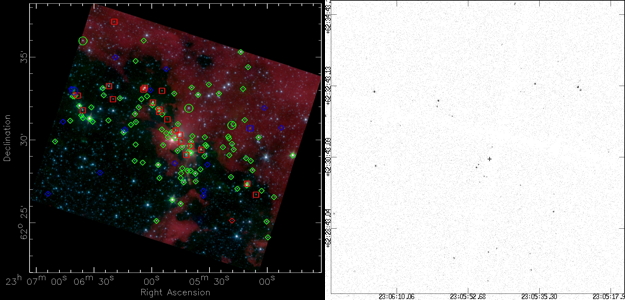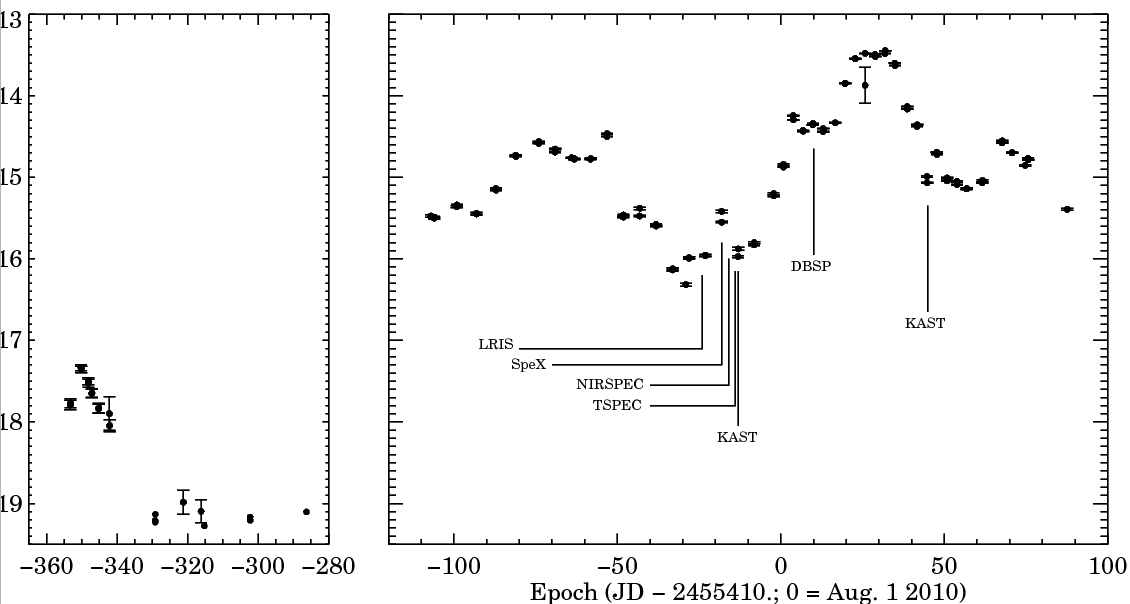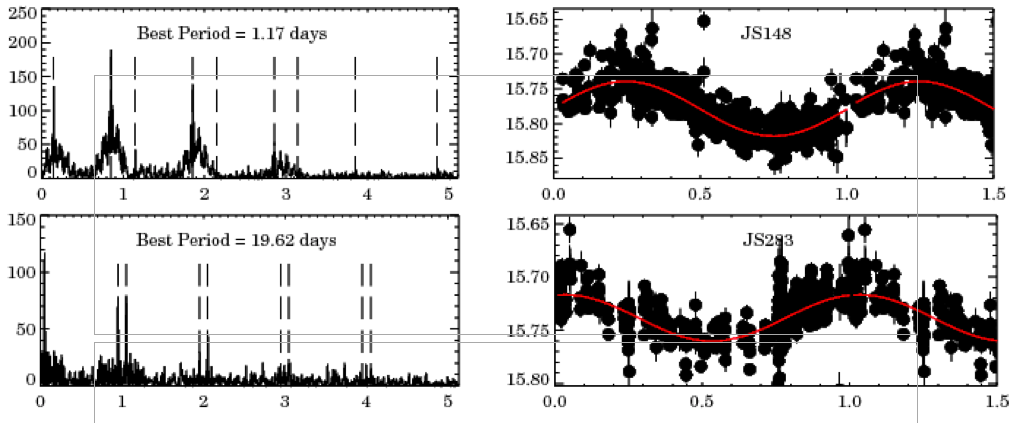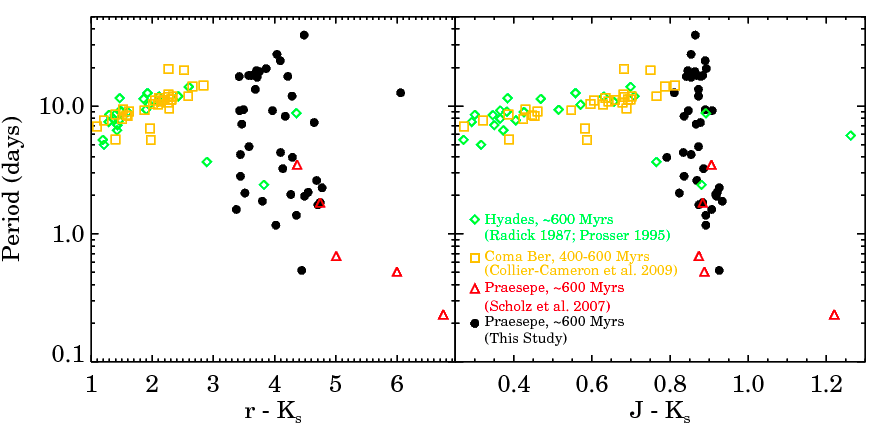Research
Low-mass stars are unique physical laboratories,
generating strong magnetic fields through a still poorly
understood dynamo process. Low-mass stars also provide critical
leverage for identifying habitable planets and
for studying the structure and history of the Milky
Way.
I am interested in understanding the
formation and evolution of these enigmatic objects.
Specifically, I want to understand:
- How do young stars accrete mass and shed angular momentum without (irreparably) disturbing the formation of planets?
- What is the relationship between a star's age, rotation rate, and magnetic 'activity', particularly at ages greater than a billion years?
Accretion Variability in Young Stars
Variability is a ubiquitious observational characteristic of young stars. This variability can arise from numerous causes: starspots moving across the star's surface; the response of the accretion shock to chaotic changes in the star's accretion rate; ehanced extinction and occultation by circumstellar dust; and at the longest wavelengths, even evolving structures within the innermost circumstellar disk. Distentangling these many components can be quite difficult, but analyzing the timescales and amplitudes of these variations can provide an important, and underutilized, lever for understanding the formation and early evolution of young stars.
I am conducting several programs that use photometric and spectroscopic variability to test models of mass accretion and angular momentum evolution in young stars. Two of these programs are being performed in concert with the larger Young Stellar Object Variability (YSOVAR) survey. The YSOVAR survey is using more than 500 hours of warm Spitzer time to characterize mid-infrared variability in young stars and their surrounding disks. I have obtained multi-epoch near-infrared spectroscopy, as well as X-ray imaging, for several embedded YSOVAR clusters, which my students and I are analyzing to determine if the mid-IR variability that YSOVAR is detecting is driven by changes in the star's accretion rate, extinction, and/or even the disk's response to high energy radiation from the central star.
 Figure 1: Mid-infrared (left) and X-ray (right)
images of the Ceph C star forming region, the target of a joint
Chandra/Spitzer
monitoring campaign conducted in Fall 2010. Coupled with
ground-based NIR broadband and polarization monitoring, these data
will demonstrate how stellar X-ray flares affect circumstellar disks.
Figure 1: Mid-infrared (left) and X-ray (right)
images of the Ceph C star forming region, the target of a joint
Chandra/Spitzer
monitoring campaign conducted in Fall 2010. Coupled with
ground-based NIR broadband and polarization monitoring, these data
will demonstrate how stellar X-ray flares affect circumstellar disks.
I am also using data from ground-based monitoring projects (the Trans-Atlantic Exoplanet Search; the Palomar Transient Factory) to study rotation and outbursts in young stars (e.g., Covey et al. 2011). This work will be even more exciting once the Large Synoptic Survey Telescope (LSST) comes online, increasing our ability to detect and study photometric variability in young stars. LSST received the highest prioritization for large ground-based projects in the recent Decadal Survey, and is on track to see first light in this decade. To help prepare for the tidal wave of multi-epoch photometry and astrometry that LSST will bring, since 2008 I have served as the co-chair of the LSST Stellar Populations Science Collaboration. To prepare for the firehose of multi-epoch photometry (and astrometry!) that LSST will bring, my colleagues and I are working with project scientists to inform and optimize the survey's design, including aspects such as the observing cadence and survey footprint, as well as verify the performance of key system components, such as the data reduction pipeline and the databases used to store and analyze LSST's catalog.
 Figure 2: R band light curve for PTF10nvg, an
young star whose outburst was identified and
characterized with photometry and spectroscopy obtained via the
Palomar Transient Factory (Covey et al. 2011). We still lack a robust understanding of
the cause of these outbursts, or even their frequency as a function of amplitude and
underlying stellar properties. LSST will detect hundreds of these
outbursts, enabling the first robust measurement of these quantities.
Figure 2: R band light curve for PTF10nvg, an
young star whose outburst was identified and
characterized with photometry and spectroscopy obtained via the
Palomar Transient Factory (Covey et al. 2011). We still lack a robust understanding of
the cause of these outbursts, or even their frequency as a function of amplitude and
underlying stellar properties. LSST will detect hundreds of these
outbursts, enabling the first robust measurement of these quantities.
The Age-Activity-Rotation Relation for Old Stars
Observational surveys have long found a close relationship between a star’s rotation period, magnetic activity, and age (e.g., Skumanich 1972). This relationship provides our primary leverage for understanding the star’s magnetic dynamo and angular momentum evolution, and underpins most age estimates for isolated field stars, including the vast majority of exoplanet hosts. Calibrating the age-activity-rotation relation at old ages is difficult, however: open clusters are the gold standard for such measurements, but they dissipate over time, so those old open clusters that remain are diffuse, distant and faint.
I am now using the Palomar Transient Factory's unique capability to obtain deep, wide field imaging with a flexible cadence to measure stellar rotation in old open clusters. Our first target is the 600 Myr Praesepe cluster (shown at the top of the page), where existing surveys have identified rotation periods for only 5 cluster members (Scholz et al. 2007). Our program has produced robust rotation periods for 40 low-mass Praesepe members, resolving distinct populations of fast and slow rotators for the first time within a cluster of this age (see figures below, and Covey et al. 2011). Coupled with optical spectroscopy and X-ray imaging for cluster members, this program will provide a complete characterization of the age-activity-rotation at the oldest ages.
 Figure 3: Example periodograms (left panels) and phased light curves (right
panels) for two Praesepe stars with high-confidence rotation period
measurements. A fast and slow rotator are shown in the top and bottom
panels, respectively.
Figure 3: Example periodograms (left panels) and phased light curves (right
panels) for two Praesepe stars with high-confidence rotation period
measurements. A fast and slow rotator are shown in the top and bottom
panels, respectively.
 Figure 4: Color-period relations for stars in ~500 Myr
clusters. Periods measured from our Praesepe monitoring are shown as
black circles; periods from other programs are shown with colored open
symbols. The Praesepe periods resolve a clear transition from a singular
color-period relation at high masses to a broader distribution of fast
and slow rotators at lower masses.
Figure 4: Color-period relations for stars in ~500 Myr
clusters. Periods measured from our Praesepe monitoring are shown as
black circles; periods from other programs are shown with colored open
symbols. The Praesepe periods resolve a clear transition from a singular
color-period relation at high masses to a broader distribution of fast
and slow rotators at lower masses.